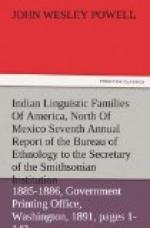> Cumanches, Gallatin in Schoolcraft, Ind. Tribes, III, 402, 1853.
> Netela-Kij, Latham (1853) in Trans.
Philolog. Soc. Lond., VI, 76,
1854 (composed of Netela of Hale, San
Juan Capistrano of Coulter, San
Gabriel of Coulter, Kij of Hale).
> Capistrano, Latham in Proc. Philolog.
Soc. Lond., 85, 1856 (includes
Netela, of San Luis Rey and San Juan Capistrano,
the San Gabriel or
Kij of San Gabriel and San Fernando).
In his synopsis of the Indian tribes[78] Gallatin’s reference to this great family is of the most vague and unsatisfactory sort. He speaks of “some bands of Snake Indians or Shoshonees, living on the waters of the river Columbia” (p. 120), which is almost the only allusion to them to be found. The only real claim he possesses to the authorship of the family name is to be found on page 306, where, in his list of tribes and vocabularies, he places “Shoshonees” among his other families, which is sufficient to show that he regarded them as a distinct linguistic group. The vocabulary he possessed was by Say.
[Footnote 78: Trans. and Coll. Am. Antiq. Soc., II, 1836.]
Buschmann, as above cited, classes the Shoshonean languages as a northern branch of his Nahuatl or Aztec family, but the evidence presented for this connection is deemed to be insufficient.
GEOGRAPHIC DISTRIBUTION.
This important family occupied a large part of the great interior basin of the United States. Upon the north Shoshonean tribes extended far into Oregon, meeting Shahaptian territory on about the forty-fourth parallel or along the Blue Mountains. Upon the northeast the eastern limits of the pristine habitat of the Shoshonean tribes are unknown. The narrative of Lewis and Clarke[79] contains the explicit statement that the Shoshoni bands encountered upon the Jefferson River, whose summer home was upon the head waters of the Columbia, formerly lived within their own recollection in the plains to the east of the Rocky Mountains, whence they were driven to their mountain retreats by the Minnetaree (Atsina), who had obtained firearms. Their former habitat thus given is indicated upon the map, although the eastern limit is of course quite indeterminate. Very likely much of the area occupied by the Atsina was formerly Shoshonean territory. Later a division of the Bannock held the finest portion of southwestern Montana,[80] whence apparently they were being pushed westward across the mountains by Blackfeet.[81] Upon the east the Tukuarika or Sheepeaters held the Yellowstone Park country, where they were




